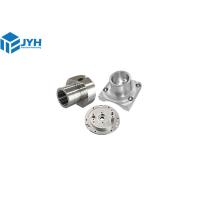OEM custom CNC lathe machining service Turning aluminum milling
precision metal parts
What Is CNC Turning?
CNC turning is a highly precise and efficient subtractive machining
process that works on the principle of the lathe machine. It
involves placing
the cutting tool against a turning workpiece to remove materials
and give the desired shape.
Parts Certifications
ISO 9001:215 | AS9100D | ITAR Registered

CNC Turning Tolerances
Type
| Tolerance |
Linear dimension
| +/- 0.025 mm +/- 0.001 inch
|
| Hole diameters (not reamed) | +/- 0.025 mm +/- 0.001 inch
|
| Shaft diameters | +/- 0.025 mm +/- 0.001 inch
|
| Part size limit | 900 * 550 * 450 mm 37.0 * 21.5 * 18.5 inch
|
What is the Difference Between CNC Turning and Milling?
While CNC turning rotates the part for cutting, CNC milling rotates
the tool to cut the part.
Going further, CNC turning will typically be used for cylindrical
parts, as you rely on the part itself to rotate and create the
friction to
remove material when the cutting tool is placed against it.
On the other hand, CNC milling can create more complex parts as it
is the cutting tool (rather than the material) that is spinning.
Our advanced CNC turning center routinely works with a wide variety
of materials, ranging from copper, brass, stainless steel, carbon
steel, aluminum, and titanium. We can always choose a suitable
precision turning process to reach your requirements. Our custom
CNC machining services ensure that our customers receive the
highest quality CNC turned parts. Send your inquiry or drawing fast
to get an online CNC quote.
Materials for CNC Turning
We stock a range of metal materials that are suitable for various
part applications and industries.
Choose from aluminum, brass, low carbon steel, stainless steel,
steel alloy, and titanium for turned parts.
The main parameters for CNC turning are:
Spindle speed. The unit is rotations per minute (rpm) and it shows the
rotational speed of the sp indle (N), thus also the workpiece. The
spindle speed is in direct correlation with the cutting speed which
also takes the diameter into account. Therefore, the spindle speed
should vary to maintain a constant cutting speed if the diameter
changes considerably.
|
Workpiece diameter. As said, this plays an important role in arriving at the right
cutting speed.The symbol is D and the unit is mm.
|
Cutting speed. The equation for calculating the cutting speed is V=πDN/1000. It
shows the relative speed of the workpiece to the cutting tool.
|
Feed rate. The unit is mm/rev and the symbol is s. Cutting feed shows the
distance the cuttingtool moves per one turn of the workpiece. The
distance is measured axially.
|
Axial cut depth. Pretty self-explanatory as it shows the depth of a cut in the
axial direction. It is the primary parameter for facing operations.
A higher feed rate puts more pressure on the cutting tool,
shortening its lifetime.
|
Radial cut depth. The opposite of axial cut, this parameter shows the depth of
cutting perpendicular to the axis. Again, lower feed rates help to
lengthen the lifetime of tools and secure a better finish.
|
CNC Turning Machine Parts
Acquiring familiarity with the parts of a CNC turning machine is
essential to grasp the process of CNC turning. Turning machine
parts vary by manufacturer, kind, and capacity. It’s important to
note that all CNC turning machines have several common parts:
- Control unit: The controller is the brain of the operation, receiving input
from the operator and translating it into actions
- Spindle: It is the part of the machine that holds and rotates the
workpiece
- Turret: The turret is a platform that holds and indexes the cutting tools
- Tool holder: Tool holders are adjustable devices holding cutting tools on the
turret
- Cutting tool: Cutting tools are used to remove material from the workpiece
Surface Finish Options for Turned Parts
( Quick-turn Finishing )
Our part finishing services are exceptional as our teams are
experts in plastic, composite, and metal surface finishing.
Furthermore, we have state-of-the-art machines and infrastructure
to bring your idea to life.

Our payment method

Our Shipping and after-sales service

Our workshop

Frequently Asked Questions
1. What is your maximum diameter capacity for turned parts?
We can turn parts with diameters ranging from 0.5mm to 65mm for
stock bars.
Our turning capabilities can reach up to 3000 mm for billets.
2. What’s the difference between CNC milling and CNC lathe?
The major difference between CNC milling and CNC lathe is in their
machining process.
CNC milling involves rotating the cutting tools against a
stationary bar stock or workpiece.
In contrast, a CNC lather works by rotating the bar stock or
workpiece against a stationary tool.
CNC milling is more suitable for machining irregular and flat
surfaces, while CNC lathes work best for
cylindrical or conical parts.
3. What parts can CNC turning make?
The CNC turning process is mostly ideal for cylindrical-shaped raw
materials.
However, several manufacturers also use it for hexagonal and
square-shaped workpieces.
It is a popular method for making machine parts for microfluidic
tools, signage components,
surgical instruments, automotive frames, and aerospace parts.
4. Can you produce plastic turned parts?
Yes, our CNC turning services include plastic parts manufacturing.
We can produce small or
large batch prototypes and production parts from various
engineering-grade plastics.
Choose from our extensive range of plastic materials and upload
your design file to get custom plastic components.
5. How about your quality?
Passed ISO9001 quality management system certification.
After the sample is approved, we will develop the operating
instructions.
We will check 100% of the product before shipping.













